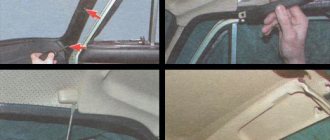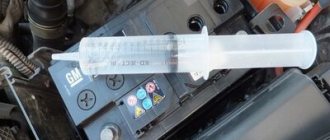Hi all! Few people leave their car in the garage for the whole winter without using it during the frost period. And winters can sometimes provoke the thermometer to drop below -20 degrees Celsius. Not all foreign cars are capable of operating in this mode. One of the solutions is a self-made car blanket.
Let me remind you that you have already talked about all the features of a purchased car blanket for an engine, its functions, capabilities and varieties. Therefore, today the main emphasis will be on how to do something similar yourself.
The answer to the question of how to sew a blanket for your engine is of interest to those who want to save money or simply do not see decent and high-quality products on the market among the options offered.
If you have personal experience in creating such a product for a car, be sure to leave reviews, share your impressions and observations on this matter.
What are car blankets used for?
The harsh winter in many regions of the country makes it clear that in such conditions, insulating your car for the winter is simply necessary. One of the key elements that needs to be protected from low temperatures is the motor. Although in fact the blanket covers almost the entire engine compartment.
see also
Motorcycle trailer: transporting and storing your bike in comfort
Car blankets are special products made from heat-resistant materials that are distinguished by their ability to retain heat. It is used for installation in the engine compartment. The main task is not to create heat, contrary to popular belief, but to preserve it. When it is very cold outside, even with a short stop, the internal combustion engine will cool down very quickly. Therefore, you will need to spend more time and fuel to warm up the car. This, by the way, brings us back to the question of whether it is necessary to warm up the engine before traveling.
Such solutions are actively used by those who live in regions with cold winters.
Moreover, the real need for a car blanket arises when there are regular trips from one point to another, and at the same time you often need to get out of the car, turn off the engine and restart the engine.
This category of motorists includes delivery service vehicles, courier services, and taxis.
If there is no insulation under the hood, then you will have to warm up the engine many times a day. What exactly this entails, you will learn from the material, the link to which I left just above.
Using a high-quality blanket or blanket for an internal combustion engine, you will extend the time during which the unit will remain at normal temperature by approximately 2-3 times and not cool down almost instantly.
To summarize, there are several reasons:
- Fuel economy. You spend less resources on warming up. Among these resources is the fuel itself;
- Save time. An extremely important resource for every person. It is unlikely that you will be pleased to spend a lot of time in place, waiting for the engine to warm up again;
- Heat saving. Warmth will be retained not only in the engine compartment, but also in the cabin. After all, the engine cooling system is directly connected to the interior heating system.
You can draw your own conclusions as to whether you should buy a blanket or not.
Although it seems to me that everything is obvious here.
DIY car blanket
The car blanket should ideally fit the size of the engine compartment so that warmth can be retained under it for as long as possible. It is not always possible to find models of blankets for a specific car on sale, and in such situations it is better to make a car blanket with your own hands. Thanks to it, it will be possible not only to make the most efficient use of the heat from the engine compartment, but also to save a lot of money, since the cost of a car blanket is quite low.
How to determine the dimensions of a car blanket during manufacture
Making a car blanket is quite simple, but the work will go down the drain if you choose the wrong size accessories. You cannot sew “by eye”; you need to correctly measure the dimensions of the engine compartment. Please note that we are talking specifically about filling the entire space under the hood of the car with a blanket, and not just covering the engine.
Below is a diagram showing what dimensions you need to measure to make your own car blanket. Please note that the dimensions themselves are given as an example only, while they are individual for each car. Having decided on the size of the car blanket, you can move on to choosing materials for sewing it.
What materials to use to make your own car blanket
Since the car blanket is located directly under the hood, it has certain requirements in terms of safety and fire resistance. Following from this, as well as from other recommendations, we can conclude that the material for a car blanket should:
- Have a high melting and ignition temperature, which applies to the filler and duvet cover;
- It does not have the highest density, since it will have to be stitched at home;
- Do not let cold air in from outside and keep warm air in the engine compartment for as long as possible.
Based on the above, you can choose a lot of materials that are suitable for making a car blanket with your own hands. But the economic component of producing an accessory for the engine compartment should also be taken into account. The most optimal materials in terms of price/quality ratio for sewing a car blanket with your own hands can be called:
- Fiberglass. It will be used as a kind of duvet cover, that is, filler is placed inside it. Fiberglass fabric is good because it fits all parameters and is highly widespread. You can buy it for sewing a car blanket at any construction market. We recommend that you contact sellers who sell fireplaces and stoves for fiberglass fabric; they always have it in stock. The cost of fiberglass is 50-70 rubles per meter;
- Izover insulation, also known as mineral (basalt) wool. The material is often used to insulate houses - walls, roofs, entrance doors, window frames and other things. It is very common, and finding Izover on sale will not be a problem. The thickness of the insulation is 50 millimeters, and it is sold in standard rolls. Mineral wool has a serious drawback - it is very itchy, which means that all work on sewing a blanket for a car must be done with rubber gloves.
Also note that sewing will require a large needle and fire-resistant thread. You can use regular thread if it is treated with a special impregnation before or after work.
How to sew a car blanket
It’s worth noting right away that making blankets for the engine compartment of a car is a job for a man. The fiberglass fabric is very dense, and it will be difficult for a woman to pierce it with a needle. To sew a blanket, you do not need any special knowledge in the field of cutting and sewing; just follow the following instructions:
- First of all, measure the dimensions of the engine compartment, as we described above;
- Next, purchase the necessary materials in the required quantities. It is better to buy with a reserve so as not to have to go to the construction market again if there is not enough isover or fiberglass;
- After this, the actual sewing process begins. Be sure to wear rubber gloves and first sew an analogue of the duvet cover from fiberglass, leaving one side unsewn;
- Fill the insides of the created duvet cover with Isover and sew it on the last side.
Since the blanket will be hidden under the hood, there is no need to worry too much about its aesthetic component - it is much more important to securely sew all sides so that the Izover does not fall out onto the engine. To protect yourself from this once again, we recommend sewing the blanket not only along the edges, but also crosswise.
Once you have sewn a car blanket, you can use it for several winters in a row. It will more than pay for itself, saving the driver gas and time.
( 418 votes, average: 4.53 out of 5)
Thermal tape for muffler, exhaust manifold
What clicks in a car after stopping the engine?
Related Posts
Safety and dimensions
Taking into account personal experience, as well as relying on the ideas and recommendations of experienced guys from Drive2 (Drive 2), we can draw some conclusions regarding making a car blanket yourself.
Let me start with the fact that it can be made. The main thing here is to choose the right composition of components in order to safely and effectively use the capabilities of the car cover.
see also
Adjusting the hubs of a light trailer
The security issue is directly related to which components will be used during creation. Such products are subject to increased requirements in terms of their resistance to high temperatures. Obviously, if you place ordinary cotton wool or some kind of woolen blanket in the engine compartment, the consequences will be quite predictable. First, the material will begin to smolder, and at some point it will simply catch fire. The whole car goes with it.
Another important point is to choose the optimal sizes.
Due to the lack of products of the required dimensions, many have to make a blanket for themselves, based on the size of the engine compartment.
Although there are many universal products on sale, it will be better if the insulation can occupy the entire engine compartment without allowing the cold to pass through.
Ready-made blankets are available on sites such as Aliexpress and similar resources.
They can be selected for different cars:
- Lada Kalina 2;
- Skoda Octavia;
- Renault Logan;
- Nissan Almera;
- VAZ 2110;
- VAZ 2115;
- Daewoo Nexia;
- Chevrolet Aveo;
- Nissan Qashqai;
- Mitsubishi Galant;
- Renault Duster, etc.
The first thing to do is take measurements of the engine compartment. Never sew by eye. Simply covering the motor will not be enough.
Car blanket: winter engine care
To use a car in the cold season, car enthusiasts always had to come up with some solutions other than long-term pre-warming of the engine, during which they had to freeze for a long time.
As a way to preserve heat, “traditional craftsmen” used sheets of felt, woolen or wadded blankets, cardboard and other materials that caught fire from time to time and, to be honest, were not as effective as the car owners wanted.
Recently, various high-tech solutions to the problem of preheating have appeared: remote or automatic engine start systems, electric or autonomous heaters, etc.
Along with these advanced and expensive means, new materials have been developed that can be used effectively and safely as a simple method of retaining heat in an internal combustion engine in the form of a special under-hood insulation - a car blanket.
What is a car blanket and why use it?
A car blanket is an insulation material that covers the engine (more precisely, the engine compartment along with the radiator, battery and other components and mechanisms in the engine compartment) from above in order to prevent its rapid cooling during the cold season.
The internal combustion engine is perhaps the most sensitive unit in relation to changes in external conditions: temperature, humidity, etc., which affects its operating modes. Most other units and mechanisms largely depend on the operation of the motor. Therefore, creating optimal conditions for its operation is an important factor in extending the service life of most structural elements of the machine.
Read also: Pros and cons of alarm systems with auto start
To manufacture the engine, materials are used whose coefficient of thermal expansion varies and lies in a fairly wide range. When calculating all engine components, the operating temperature (80-95 degrees Celsius) is taken into account. While the engine is warming up, the wear of all its components and parts increases significantly. Naturally, the lower the temperature at which the engine starts, the more all its parts will wear out.
In this case, aluminum components will melt, slag will form in mineral motor oils, and varnish deposits, carbon deposits and sludge will form on the surfaces. The content of nitrogen oxide in the exhaust gases will be much higher, and on the walls of the cylinder block parts and pistons, corrosive wear processes will be intensified due to water condensate and various acids.
Therefore, if possible, it is necessary to avoid starting the internal combustion engine at low temperatures and use various auxiliary means, one of which is car blankets.
Types of car blankets
Any such product is based on thermal insulation materials with low thermal conductivity. The following insulation materials are currently used:
— Felt (keeps heat well, but in terms of fire safety there may be questions about it); — Fiberglass (an inexpensive material that retains heat well); — Mullite-silica materials (modern fibers made of aluminum and silicon oxide, characterized by chemical and temperature resistance).
Thermal insulation materials are placed in an outer covering of fabrics that are particularly resistant to temperature and fire. Often a mirror film is applied to their shell, which reflects heat. Special synthetic, especially strong threads are used for stitching.
When developing these, at first glance, rather simple products, the possibility of emergency situations in which the temperature can increase significantly is taken into account. Although when the engine is running, the temperature in the engine compartment rarely rises above + 100 degrees Celsius
The materials from which car blankets are made are designed to withstand much greater heat. So, for example, impregnated felt products can withstand + 300 degrees Celsius, glass wool car blankets can be operated at temperatures of + 700-800 degrees Celsius, and advanced mullite-silica ones can withstand + 1200-1300 degrees Celsius.
The main advantages of car blankets
Materials used
If you visit a thematic forum, you can come across many questions and discussions on the topic of making your own car blanket.
Moreover, anyone who has encountered this personally will say that the material plays a key role. Yes, you can do without fiberglass. But then you will have to decide what to make a high-temperature-resistant coating for the internal combustion engine from.
The filler, as well as the outer shell of the blanket, must meet the following requirements:
- have a high melting point;
- provide high temperatures for ignition;
- offer a medium level of density due to the need to stitch the material;
- provide the ability to cut into the required lengths;
- do not allow outside cold air to pass through;
- do not release heat for as long as possible.
Watching a video on this topic, you will notice that all the masters use a variety of materials.
From the standpoint of optimal price-quality ratio, fiberglass and basalt wool (isover) are best suited.
Sewing is carried out using a large needle and threads with fire-resistant characteristics.
Please note that the cotton wool will be prickly, making it not very pleasant to work with.











